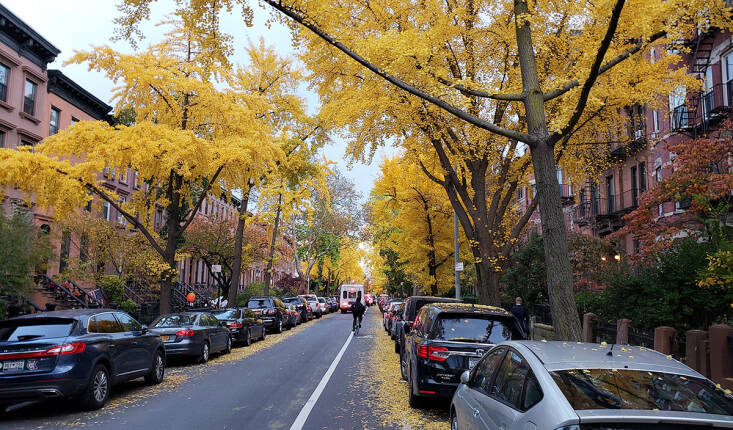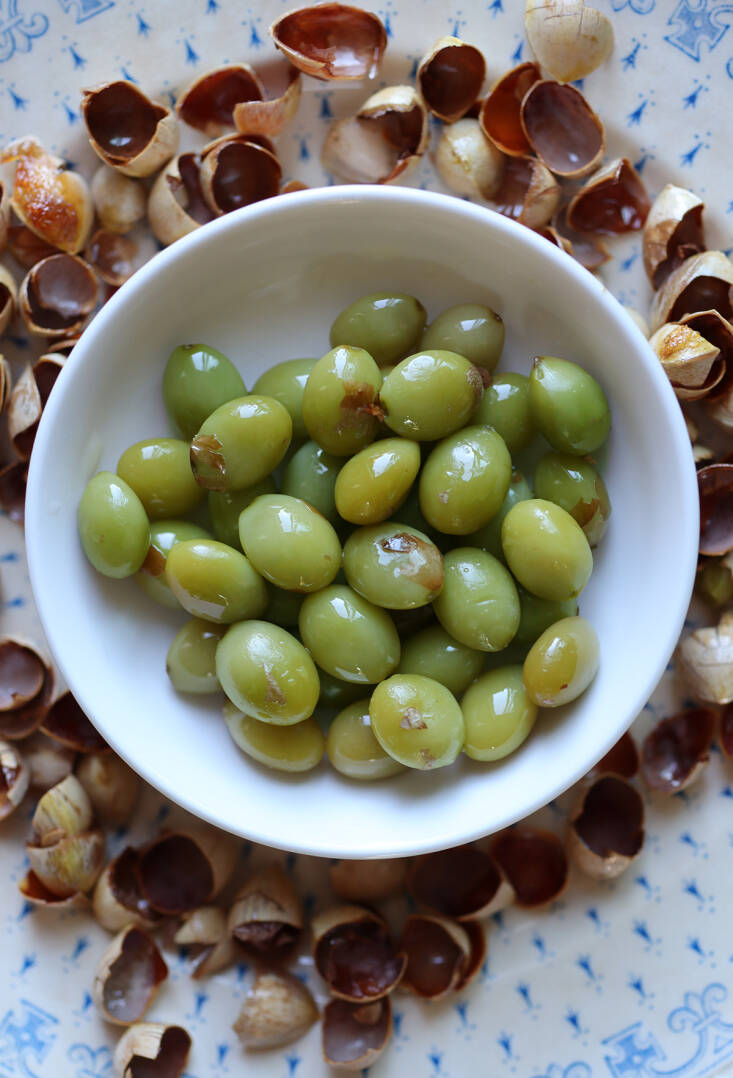In New York City, there are street tree seasons that make whole neighborhoods smell very good—like early summer, when lindens are in sweet bloom. And there is a season that is more…challenging, in the olfactory sense: Fall, when female ginkgo trees drop their wrinkled and stinking fruit. These ancient trees are one of the oldest organisms on earth; they were the familiars of dinosaurs, which they outlasted. Ginkgos are unique in several ways, and the stench of their broken fruit is just one of their mysteries (for whom was the putrid smell an irresistible call to feast?). That uniquely stinky pulp hides a delicious secret: A pistachio-like shell that protects their sought-after kernel, or Ginkgo “nut”, a highly-valued functional food in East Asia for millennia.
Preparing ginkgo nuts to eat is easy, and the reward is delectable.
Photography by Marie Viljoen.

Freshly-cooked ginkgo kernels (they are not actually nuts) are delicious—tasting something like a hybrid of chestnut, pine nuts, and tofu—and they are absolutely odor-free. Ginkgo is commonly eaten in China, Korea, and Japan.

My own ginkgo adventures began relatively late in my foraging life, in the autumn of 2018. Emboldened by the Asian women I saw gathering fallen fruit under female trees in Brooklyn’s Prospect Park every fall, I shyly followed their example, scooping the ripe fruit up carefully in hands protected by gloves. The women also wore plastic bags over their shoes, to protect them from the reeking pulp. (Unbroken fruit does not smell). Back home, after cleaning, boiling, and roasting them, I tasted my first, fresh, vividly green ginkgo “nut,” It was love at first bite.

Ginkgo trees are rare in the wild (and they reside in China). But there are plenty scattered in cities around the globe, planted in regions with cold winters and humid summer. The trees are resilient, pest-free, and beautiful. For ornamental purposes, male trees are preferred, since they form no smelly fruit. But females trees do sneak in, and that is very lucky for urban dwellers who appreciate the bounty when it falls in mid-autumn.

Ginkgo biloba is the only species in the genus Ginkgo. That genus is the only one in the family Ginkgoaceae, which is the only occupant of the order Ginkgoales, which is the sole member of the division Ginkgophyta. The fossil record of ginkgo is over 200 million years old.

Ginkgo fruit does contain toxins: In the raw pulp there is urushiol (think poison ivy) which can cause contact dermatitis. Wearing gloves is important when handling any broken fruit or when removing the kernel. (Interestingly, the raccoons and possums who relish city ginkgo—eating the smelly pulp only—don’t know about the glove-rule and seem to be just fine.)
The kernel of ginkgo contains cyanogenic glycosides, which are heat-sensitive, and are destroyed by cooking. There is also so-called ginkgotoxin, a neurotoxin that is not heat-sensitive; it inhibits the absorption of Vitamin B6, which is essential for nervous system development. In a case of overdose the kernels can cause illness and even seizures. According to the authors of a 2020 paper documenting a single case of presumed ginkgo poisoning case in Japan, “seven to 150 pieces for children and 40 to 300 pieces for adults are the ranges for overdose.” That’s very broad! (The person in question ate around 80, if you’re curious, and was also described as “actively alcoholic.”) A Japanese friend who has eaten ginkgo all her life—she is in her 70s—cuts herself off at 12.

Now that you’re thoroughly warned here’s how to collect and eat ginkgo:
Safety: Wear gloves to collect ginkgo fruit as any broken pulp can irritate sensitive skin and cause a rash. Never eat ginkgo kernels raw. Traditional wisdom says not to eat too many ginkgo “nuts” at one time. Traditional advice ranges from 10 to 30. Avoid feeding ginkgo kernels to young children.
To Clean the Ginkgo Fruit:
Best done outdoors, because the smell lingers. You need three bowls:
1 bowl filled with ripe ginkgo
1 large bowl filled with water
1 small bowl for cleaned seeds
Wearing gloves, squeeze the hard seed out of the soft pulp. Drop the naked seed into the bowl of water. When all the seeds have been popped out, swoosh them clean in the water, rubbing each seed free of any clinging pulp. Transfer the cleaned seeds into the small bowl. Discard the water, re-fill the large bowl and rinse the seeds one more time.

Bring a pot of water to a boil on the stove. When it boils, add the washed seeds. Boil the clean seeds for 2 minutes, and drain. They are now smell-free. You can either freeze them in small batches to cook later, or carry on to the next steps.
4 Ways to Prepare Ginkgo

Boiled
After the initial 2 minutes, continue boiling the ginkgo for another 2 minutes. Drain. Using a nut cracker or small hammer, gently crack each seed and peel off the shell. The beautiful green kernel can be eaten just like that, while warm, or you can shell them all to use in moderation in soups or snacks.

Pan-Roasted
Pan-Roasted (my favorite): After the 2-minute boil, pan-roast the boiled seeds with some neutral oil and salt in a covered skillet until they begin to pop ( a bit like popcorn). It takes around 2 – 3 minutes and the popping also helps split the shells open. Shell and eat.

Oven-Roasted
Oven-Roasted with Salt: After the 2-minute boil, toss the boiled ginkgo seeds (still in their shells) with sea salt and a neutral oil like avocado, and roast for 8 minutes at 350°F. Most seeds will split for easy shelling. Crack the ones that do not. Eat warm or cool.
Oven-roasted with Shoyu: Toss the boiled seeds with some neutral oil, a splash of good shoyu or soy sauce, lay on a baking sheet and roast for 8 minutes at 350°F.

Skewered
Skewers: After the initial boil, crack and shell the ginkgo seeds carefully and thread the kernels onto small bamboo skewers. Season with sea salt and some neutral oil, and roast them for 6 minutes under a broiler, turning once. (If you have charcoal brazier, grill them yakitori-style, instead.)

To revive frozen ginkgo seeds simply allow them to thaw for 20 minutes, then skillet-roast them per the instructions above. They retain their lovely green color and are best eaten warm.
For more of Marie’s recipes, see:
- A Unique Seasonal Treat: Spiced, Candied Crabapples
- Myoga Buds: How to Grow the Autumn Asian Delicacy
- Lablab: An Ancient Crop and Stunning Vine












Have a Question or Comment About This Post?
Join the conversation (0)